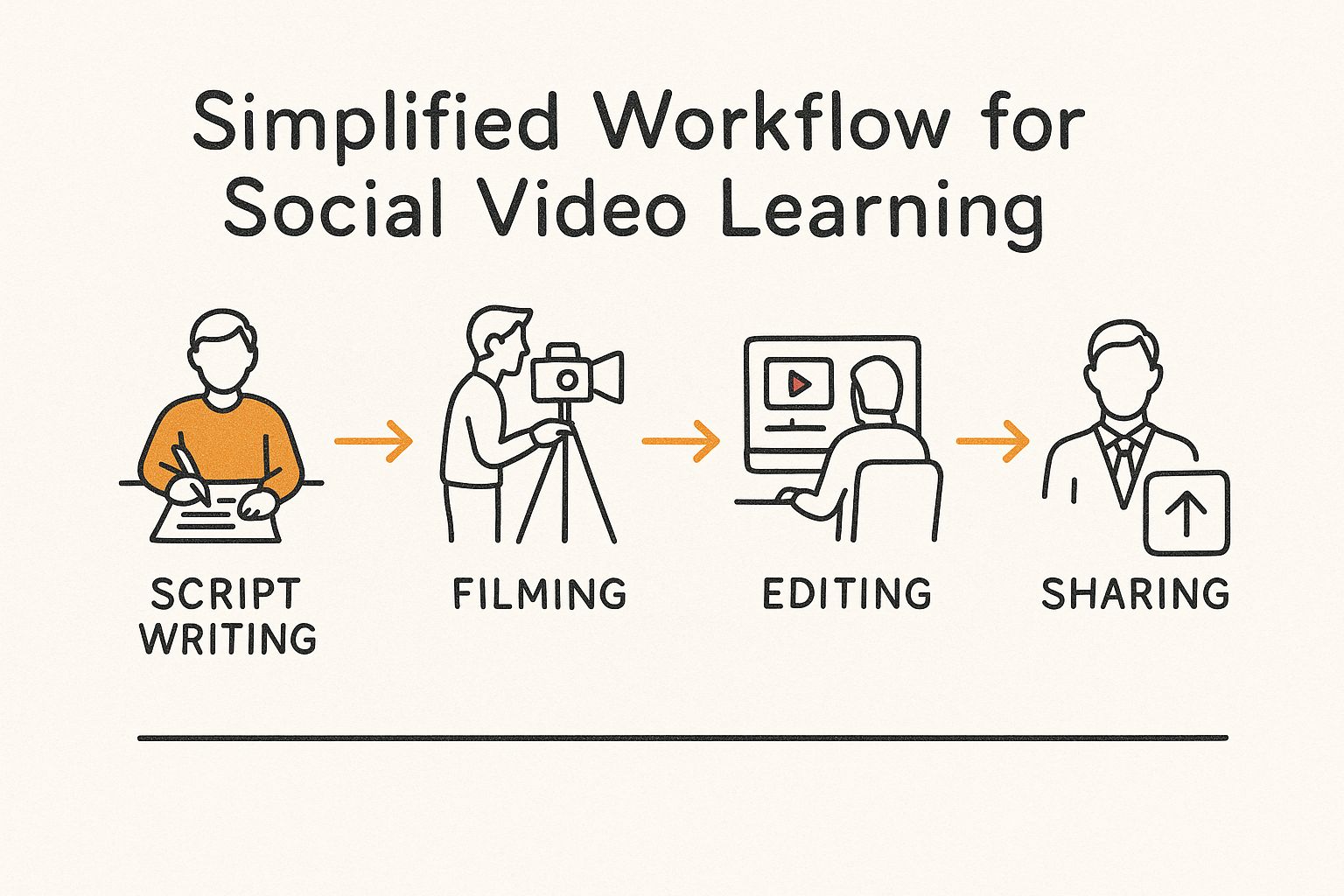
Boost Corporate Training with Interactive Video
When we talk about video marketing for social media, we're talking about a strategic game plan. It’s about using video on platforms like LinkedIn, Instagram, and YouTube to hit specific business goals. In the world of corporate training, this means it's time to ditch the static, soul-crushing presentations. Instead, we can create dynamic learning experiences that actually grab employees' attention, help them remember what they’ve learned, and deliver real, measurable results.
Why Social Video Is Reshaping Corporate Training

There’s a massive shift happening in corporate learning and development (L&D), and it's long overdue. The days of clicking through endless slideshows and drowning in text-heavy manuals are numbered. They're being replaced by a method that actually fits how your team consumes information in their daily lives: video.
Think about it. Your employees are already scrolling through short, snappy videos on their own feeds for everything from news and entertainment to quick "how-to" tutorials. That constant exposure has trained them to expect information in a format that's visual, engaging, and easy to digest. Smart companies are now bringing that exact same energy to their internal training programs.
The Power of Social Learning Principles
By adopting a video marketing for social media mindset, L&D teams can flip the script on training. It stops being a mandatory chore and starts becoming a valuable, engaging part of the job. But this isn't just about making pretty videos; it's about building an entire social learning ecosystem.
Here’s what that really means in practice:
- Boosting Engagement: Short, impactful videos are attention magnets. They cut through the noise far more effectively than a dense document ever could, which naturally leads to more people participating.
- Improving Knowledge Retention: It’s simple science. The combination of seeing and hearing in video makes complex information stick. It's easier to understand and, more importantly, easier to remember.
- Fostering Community: When you make training videos shareable and enable comments on your internal platforms, you spark conversation. Suddenly, people are learning from each other, not just from the content.
The big idea here is to make corporate education feel as intuitive and effective as scrolling through a social media feed. When training feels less like a lecture and more like a helpful discovery, your team is far more likely to absorb and actually use what they've learned.
Turning Passive Viewing into Active Learning
But the real magic happens when you move beyond just watching. The goal is to make videos interactive. This is where platforms like Mindstamp become absolutely essential, allowing customers to create engaging, interactive learning and training content. With Mindstamp, you can embed questions, polls, and even branching "choose-your-own-path" scenarios directly into the video.
This simple step transforms passive viewing into an active learning experience.
Interaction provides immediate feedback, reinforcing key concepts in the moment. Even better, it generates priceless data that shows L&D teams exactly where employees are getting it and where they might be struggling.
The business impact of video is already proven in the marketing world. A staggering 91% of consumers have watched an explainer video to learn about a product. And 90% of marketers report that video delivers a good return on investment. The same principles that drive sales can be used internally to "sell" new skills and knowledge to your team. As you can see from insights on Vidico.com, this is a proven strategy, making video a powerful tool for solving your biggest training challenges and showing clear value back to the business.
How Interactive Video Elevates Employee Development
Let's be honest: standard training videos can feel like a lecture. They’re a one-way street of information that’s passive and, too often, quickly forgotten. Interactive videos completely flip that script. Think of them less like a lecture and more like a hands-on workshop—they pull employees into the experience, turning learning into an active dialogue.
This isn't just about making training more "fun." When employees are actively clicking, deciding, and answering questions, their brains are forced to engage with the material on a much deeper level. Instead of just watching, they’re participating. That simple shift dramatically boosts focus and, more importantly, knowledge retention.
From Monologue to Dialogue
The real magic happens when training transforms from a monologue into a genuine conversation. This is where purpose-built features in interactive video platforms like Mindstamp come into play, making the entire learning experience feel responsive and personal.
A few key features make this possible:
- Clickable Hotspots: Imagine a new hire learning to use a piece of complex equipment. Instead of just hearing about it, they can click a hotspot placed directly on a machine part in the video to instantly pull up detailed specs or a critical safety warning. All without breaking the flow.
- In-Video Questions: You can drop multiple-choice or open-ended questions right into the training content. This gives you a chance to reinforce key concepts on the spot and lets employees immediately check their understanding.
- Branching Scenarios: This is a game-changer for skill development. A sales trainee can face a simulated customer objection, choose how to respond, and immediately see the consequences of that choice play out in the video. It’s a safe space to practice and fail without real-world risk.
This level of interaction goes far beyond just delivering information. It actively builds the critical thinking and decision-making skills employees need by letting them apply their knowledge in a practical context.
Personalized Learning and Measurable ROI
One of the biggest wins with interactive video is the ability to create truly personalized learning paths. Not every employee starts from the same place. Branching can let experienced team members test out of sections they already know, while new hires can dive deeper into foundational topics where they need more support.
This makes training far more efficient and respectful of everyone's time. For anyone looking to get started on the technical side, there are guides that walk through the entire process of how to create interactive videos.
But for L&D teams, the data is everything. Every click, answer, and decision becomes a valuable data point. This gives you concrete proof of training effectiveness that goes way beyond simple completion rates.
Finally, you can answer the big questions with confidence. Are employees really grasping the new compliance rules? Where are the knowledge gaps on the sales team? Interactive video analytics pinpoint these problem areas with precision, showing you exactly where to focus your follow-up efforts.
Ultimately, this data gives you a clear line to your return on investment (ROI). By identifying and closing knowledge gaps, you can directly connect your training initiatives to better performance, higher compliance, and a more capable workforce. It turns L&D from a cost center into a proven engine for business growth.
Building Your Social Video Learning Strategy
Let's be honest: turning your corporate training from a series of dusty PowerPoints into something people actually want to watch requires a real strategy. It’s not enough to just start making videos and hope for the best. The secret is to build a system that borrows from the playbook of what makes social media so addictive and compelling in the first place.
This means being thoughtful and deliberate. It's about prioritizing clear goals, knowing your audience inside and out, and creating authentic content that doesn't require a Hollywood-sized budget.
A solid strategy always starts with the end goal in mind. Before you even think about hitting the record button, you need to define what success looks like. Is your goal to slash onboarding time for new hires by 25%? Or maybe you need to hit 100% compliance on a new safety protocol.
These sharp, measurable objectives are your North Star. They guide every single decision you make, from what you say in the script to how you share the final video. Without them, you're just making content. With them, you're building a solution to a real business problem.
Defining Your Audience and Their Needs
Once your goals are crystal clear, it’s time to get to know your audience. A social media marketer would never create a one-size-fits-all campaign, and neither should you. You have to segment your employees. The learning needs of a brand-new manager are worlds apart from a seasoned customer service rep or a C-suite executive.
A great way to do this is by creating simple employee personas to keep your content focused:
- New Hire Noah: He’s just starting out and needs the basics delivered in short, easy-to-digest pieces. Think onboarding checklists, quick "how-to" clips, and friendly welcome videos from the team.
- Upskilling Uma: She’s a mid-level pro looking to climb the ladder. She’ll get the most value from in-depth tutorials, interviews with experts, and maybe even branching scenarios that let her test her decision-making skills.
- Leadership Liam: Time is his most valuable asset, so he needs high-level strategic insights, fast. Short video summaries of quarterly reports or quick Q&A sessions with other leaders are perfect for him.
When you segment like this, your training videos feel relevant and respectful of everyone's time and role. It's the difference between a generic, all-staff email that gets ignored and a personal message that speaks directly to someone's daily challenges and career goals.
This infographic breaks down the simple four-step workflow for getting your social learning videos made and shared.

As you can see, it maps out a clear path from scripting and filming right through to editing and sharing, turning the big idea into something your team can actually watch.
Matching Video Formats to Corporate Training Goals
Choosing the right video format is crucial for hitting your training targets. A quick tutorial is great for one goal, while a detailed simulation is better for another. This table helps break down which formats work best for common L&D objectives.
By aligning the video type with the learning goal, you ensure the content isn't just watched, but that it actually drives the behavior or skill you’re aiming for.
Crafting a Content Workflow That Works
With your goals and audience figured out, you can build a workflow that values authenticity and speed over polish. You need to let go of the idea that every corporate video needs a massive budget and a full production crew. Often, the most effective training content feels real and relatable—something filmed on a smartphone with good, clear audio.
Your workflow should be all about creating value. Scripts should be conversational, not bogged down in corporate jargon. Editing can be simple, maybe just adding some text on-screen to call out key takeaways or cutting out long pauses. This lo-fi approach makes it possible for subject matter experts across the company—not just the L&D team—to create and share their knowledge.
The ultimate goal is to build a true social learning ecosystem. This means moving beyond one-way content delivery and fostering a culture where employees learn from both the videos and each other.
This is where your distribution strategy makes or breaks your success. Don't just bury your amazing new videos on some forgotten corner of the intranet. Share them where your people already are.
Drop a new sales technique video in the #sales channel on Slack. Start a discussion thread on Microsoft Teams about a new software tutorial. Encourage people to ask questions, leave comments, and even reply with their own short videos sharing tips. By using these internal social channels, you transform training from a passive viewing experience into an active, collaborative one that builds skills and community at the same time.
Using Social Media Tactics for Corporate Learning
You don't need to reinvent the wheel to make corporate training stick. Just look at what's already capturing everyone's attention on the world's most popular platforms. The same tactics that make social media videos so addictive can be pulled directly into your learning and development strategy, turning passive training into something people actually want to engage with.
The trick is to borrow the formats your employees already know and love. By mirroring the experience of platforms like Instagram Reels, YouTube Live, and TikTok, you can deliver information in a way that feels natural and modern, not like a stuffy corporate mandate. It’s all about meeting your team where they already are.
Mastering Microlearning with Reels-Style Videos
Think about the power of a 90-second Instagram Reel. It grabs you, teaches you something, and then you're on to the next one. This is the perfect blueprint for microlearning, a strategy that breaks down big, complex topics into bite-sized, digestible pieces.
You can create short, punchy "Reels-style" videos for quick, single-skill tutorials that employees can watch on any device, anytime.
- Software Tip of the Week: A 60-second screen recording showing a killer shortcut in your company's CRM.
- Safety Snippet: A 45-second clip demonstrating the right way to operate a new piece of equipment.
- Compliance Reminder: A quick, animated video that highlights one key point from a new company policy.
These clips are perfect for reinforcing knowledge without eating up the workday. They're also incredibly easy to share on internal channels like Slack or Teams, delivering high-impact info that respects everyone's time.
Driving Real-Time Engagement with Live Sessions
There's an energy to live video that you just can't fake. It's unscripted, immediate, and creates a real connection. Platforms like YouTube Live and LinkedIn Live have perfected this, opening a direct line between creators and their audience. You can bring that same dynamic into your training programs.
Hosting live video sessions creates a sense of community and urgency around learning. It’s a chance for direct, unfiltered interaction that pre-recorded content just can't match, making experts and leadership feel way more accessible.
Imagine hosting a live Q&A with a product expert right after a new launch, or a town-hall-style session with leadership to break down quarterly goals. Employees can jump in with questions, get answers on the spot, and feel like they’re part of the conversation. It's a fantastic way to build transparency and foster a more open culture.
Creating Clarity with Explainer Videos
Of course, some topics are just too beefy for a 90-second clip. When you need to unpack a new process, walk through a complicated software setup, or detail a strategic plan, the classic "explainer video" is your best friend. They're longer than micro-videos but are laser-focused on one comprehensive subject.
The data is clear on this. Video is fundamentally changing how we all learn and consume information. By 2025, video is expected to make up 82% of all internet traffic, and a whopping 73% of consumers prefer short-form videos when learning about a product or service. These aren't just consumer trends; they're human trends, and corporate learning can and should tap into them.
Empowering Employees with User-Generated Content
One of the most powerful things about social media is that it gives everyone a voice. You can unlock a goldmine of practical, peer-to-peer knowledge by encouraging user-generated content (UGC) inside your own organization.
Invite employees to create and share their own short videos on best practices, handy tips, or recent wins. Think of a top salesperson recording a quick video on their phone explaining how they handle a common client objection. This not only generates authentic, relatable training content but also celebrates your internal experts.
Once you have these great assets, knowing how to distribute the video across your internal platforms is the crucial final step to make sure they reach the right people and have a real impact.
Creating Training Videos Employees Actually Watch

It’s one thing to make a training video. It's another thing entirely to make one that your team doesn't immediately tune out. The real goal isn't just to check a box; it's to deliver knowledge that actually sticks. To do that, we need to borrow a few tricks from the world of video marketing for social media, where attention is everything.
The rules are pretty simple, but they’re not suggestions. First, you have to nail the hook. Those first three seconds are your entire window to grab a viewer with a sharp question, a surprising stat, or a clear promise of what they're about to learn. If you miss that window, you've already lost them to another browser tab.
Just as critical is crystal-clear audio. People will forgive shaky camera work or less-than-perfect lighting, but they will absolutely not tolerate muffled, distorted, or quiet sound. A decent microphone is probably the single best investment you can make to instantly boost the quality of your training videos.
Designing for the Modern Learner
Let’s be real: your team is consuming content on the go, which means optimizing for mobile isn’t optional anymore. Your videos need to be framed and edited to look great on a small, vertical screen. This means using big, easy-to-read on-screen text to drive home key points and make the content easy to follow, even with the sound off.
Think of your on-screen text as a silent co-host. It guides the eye, highlights what’s most important, and makes sure the core message gets through, whether someone’s watching at their desk or on a noisy train.
And don't forget about tone. Ditch the stiff, formal corporate script. You want to sound like a knowledgeable colleague sharing helpful advice, not a robot reading a teleprompter. That one shift makes the material far more relatable and keeps people engaged.
The most effective training videos feel less like a mandate and more like a valuable resource designed to help employees succeed. By focusing on clarity, authenticity, and mobile-first design, you create a learning experience that respects their time and attention.
Driving Action and Measuring Outcomes
A great training video shouldn't just inform—it should prompt action. This is where a strategic call-to-action (CTA) becomes your most valuable tool. Instead of fading to black with a generic "Thanks for watching," you need to guide your employee to the next logical step.
A good CTA bridges the gap between learning something and actually doing something with that knowledge. It gives them a clear path to apply what they’ve just learned. For inspiration on what grabs attention, it can be helpful to look outside the corporate world by understanding ad creative trends on social platforms.
Here are a few examples of action-focused CTAs you can build right into your videos, especially with an interactive platform like Mindstamp:
- Complete a Knowledge Check: "Ready to test what you've learned? Click here to take a quick quiz."
- Download a Resource: "Want a handy reference? Download the one-page job aid for this process now."
- Practice a New Skill: "Your turn! Open the software and complete this exact task."
- Join the Discussion: "Have questions? Join the conversation in our #training Slack channel."
By embedding these kinds of prompts, you turn a passive viewing session into an active learning moment. Even better, these actions are measurable. L&D teams can track not just who watched the video, but who engaged with it, understood the material, and took the first step toward putting their new skills to use. This creates a direct line between your video content and real, tangible learning outcomes.
Measuring the True Impact of Your Video Training
For any corporate training to stick, you have to prove its worth to leadership. When it comes to video, it’s so easy to get fixated on vanity metrics like views and likes. While those numbers might look impressive on a report, they don't tell you if anyone actually learned anything.
To show you’re making a real difference, you have to dig deeper than the surface-level data. The conversation needs to shift from "how many people watched?" to "what did they understand, and what can they do now that they couldn't before?" This is exactly what an interactive video platform like Mindstamp is built for—tracking the meaningful data that paints a clear picture of actual learning.
Going Beyond the View Count
Traditional video analytics tell you if a video was played. That’s about it. They can't tell you if it was effective. Interactive video analytics, on the other hand, give you a direct window into the learning process. You can learn more about the specifics of what is video analytics in our detailed guide.
Here are the metrics that actually show you what’s happening:
- Viewer Engagement Scores: Think of this as a single, powerful number that combines multiple interaction points—clicks, answers, time spent—to show how actively an employee was participating.
- Completion Rates: Knowing that 95% of employees finished a compliance video is a powerful stat. It proves the program's reach and shows everyone is on the same page.
- Question Accuracy: This is where the magic happens. Tracking how employees answer in-video questions gives you concrete proof of knowledge retention and helps you spot the exact topics where they might be getting stuck.
Tracking these granular metrics is essential. It transforms your training from a "black box" into a transparent process where you can pinpoint knowledge gaps, reinforce difficult concepts, and prove that real learning is taking place.
Connecting Learning Metrics to Business Outcomes
The ultimate goal is to tie these learning metrics back to tangible business outcomes. Just like smart companies measure marketing ROI to justify their external spending, you can apply the same thinking to your internal training programs.
For instance, you can analyze the user paths in a branching scenario to get a fascinating look into your team's decision-making process. Are new sales reps consistently picking the best response to a customer objection? Are managers navigating a tricky conversation simulation effectively? The data from these interactions provides direct evidence of skill development.
This allows you to draw a straight line from your training to the KPIs that leadership truly cares about.
- Faster Onboarding: Show that new hires who complete the interactive video series reach full productivity 20% faster than those who don't.
- Improved Compliance: Report a 50% reduction in safety incidents after rolling out a new interactive safety protocol video.
- Increased Sales Performance: Demonstrate that reps who scored above 90% on product knowledge quizzes closed 15% more deals the following quarter.
This data-driven approach is critical. With social media ad spend projected to hit $276.7 billion in 2025, a huge chunk of that is going to video for one simple reason: it works. The same power can be put to work inside your organization. By connecting interactive video analytics to bottom-line results, you can demonstrate a clear, undeniable ROI for your program and secure the buy-in you need for future investments.
Got Questions? We've Got Answers.
Switching to a social-style video training program is a big move, and it’s natural for L&D pros to have questions. You've got to think about everything from getting leadership on board to making sure your team actually engages with the material. Let's clear up a few common hurdles.
How Do I Get Employees to Actually Watch Training Videos?
The secret is to create content that respects their time and intelligence. Nobody wants to sit through another long, generic lecture. The key is to create short, role-specific videos that solve a real problem they’re facing right now.
But the real game-changer? Making it interactive. When employees know they’ll be asked to participate—whether through questions, polls, or real-world scenarios—they lean in. It shifts the experience from passively watching to actively doing, which is infinitely more interesting.
Can Video Training Really Work for Complex Topics?
Absolutely. While short videos are perfect for quick hits of microlearning, you can absolutely apply the same principles to meatier subjects like compliance or leadership development. In fact, for these topics, interactive video isn't just a nice-to-have; it's essential.
Think about it. You can use features like:
- Branching Scenarios: Let your managers practice tricky conversations in a safe, simulated space.
- Clickable Hotspots: Allow learners to explore complex software or detailed diagrams on their own terms, at their own speed.
- In-Video Resources: Embed links to deeper-dive documents or policies for anyone who wants to learn more.
How Can We Justify the Cost to Leadership?
This is the big one. The best way to get buy-in is to stop talking about vanity metrics like view counts and start focusing on tangible business outcomes. A solid interactive video platform gives you all the data you need to build that business case.
Instead of reporting that 80% of the team viewed the new compliance video, report that 95% of them passed the in-video quiz, demonstrating full comprehension. Show how interactive sales simulations directly correlate with higher quota attainment.
When you can draw a straight line from your training program to the KPIs leadership obsesses over, the investment doesn't just make sense—it becomes undeniable.
Ready to stop making training videos people have to watch and start making ones they want to watch? Mindstamp gives you all the tools you need to build interactive videos that grab attention, lock in knowledge, and deliver real, measurable business results. Start building your first interactive training video today.
Get Started Now
Mindstamp is easy to use, incredibly capable, and supported by an amazing team. Join us!



Try Mindstamp Free










